Auras Shagon ARC-118 and AHC-118 CPU Coolers Review

This is a story about two very simple, but not very cheap coolers with Direct-Contact technology and the results of their cooling efficiency tests.
About three years ago we tested cooling products from the Taiwanese Auras Technology Co., Ltd. back then we were most excited about the new Transformer (CTC-868) CPU cooler and a large and efficient Fridge (JES-988) VGA cooler. Judging by the coolers available on the company web-site today, Auras hasn’t really come up with anything new since then. But recently there appeared two new CPU coolers called Auras Shagon. The company considered these two models to be so interesting that they even created a separate site for them, which doesn’t yet work for some reason. However, our today’s review is ready and we are going to tell you everything about these two products.
Closer Look at Auras Shagon ARC-118
Both coolers have similarly designed packaging. The boxes differ only by the model name and technical specifications:
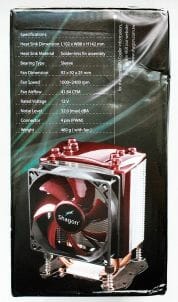
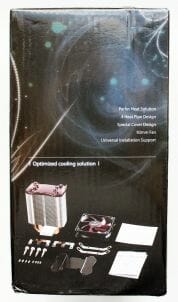
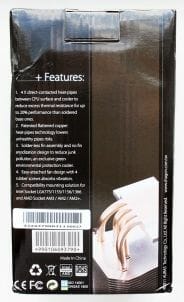
Despite the fact that on the way to us the boxes obviously went through some transportation ordeal (as you can tell by their looks), the coolers inside remained perfectly safe and intact. The accessories are neatly arranged at the top of the boxes:
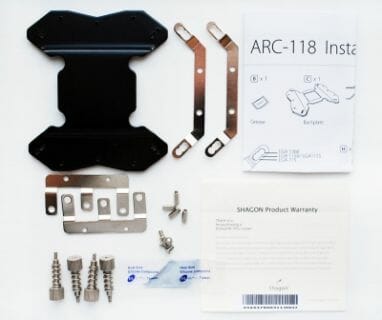
The accessories are the same for both models and include a steel backplate, two sets of retention brackets, screws, bushes, installation guide and a pack of SilMORE thermal paste. Both coolers are made in China.
Just like the higher-end model, Auras Shagon ARC-118 boasts very modest exterior. Only the dark-burgundy fan impeller that matches the top plastic cover on the heatsink adds a little character to it:
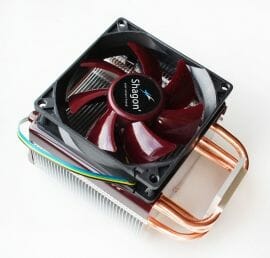
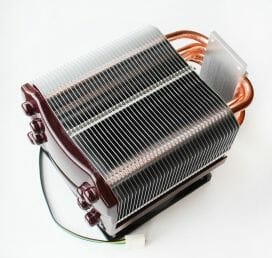
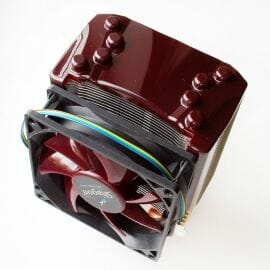
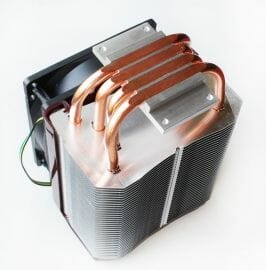
The cooler is not too big and not too heavy. It is 139 mm tall, 101 mm wide and 88 mm deep and weighs only 460 grams (with the fan).
The heatsink consists of 37 aluminum plates 0.4 mm thick that are pressed onto the heatpipes at 2 mm distance from one another:
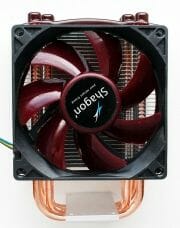
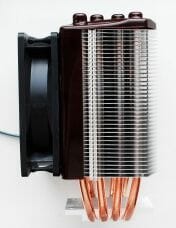
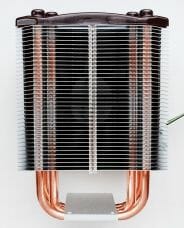
There are four copper heatpipes 6 mm in diameter. They aren’t laid out linearly inside the heatsink, which is supposed to improve the heatsink cooling efficiency:
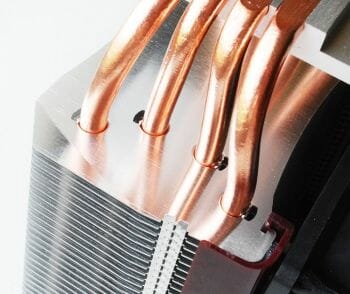
Heatpipes direct-touch technology called in Auras’ interpretation “Direct-Contact” has been implemented in Shagon ARC-118 in the simplest, even somewhat outdated manner: the heatpipes are pressed into the aluminum insert filling into the 2 mm gaps between them:
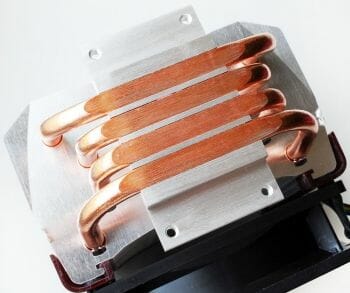
The contact surface of the base is finished in a pretty common way for coolers with this type of base, although one side of the two central heatpipes pushed a little too deep into the insert, which you can notice from the thermal paste imprints:
The integrity of the contact between the CPU heat-spreader and the cooler base as well as the retention pressure are of utmost importance for coolers with Direct-Contact technology, and here we see this unforgivable defect. It may inevitably affect the cooling efficiency of this product, but let’s not get ahead of ourselves just yet.
Auras Shagon ARC-118 is equipped with one seven-blade PowerLogic fan 92x92x25 mm in size.
The fan rotation speed should be adjusted automatically using pulse-width modulation approach in the interval from 1000 to 2400 RPM creating maximum airflow of 41.84 CFM and generating 32 dBA of noise. Although in reality the fan turned out completely noiseless simply because it didn’t work. I also have to add that the fan’s maximum power consumption wasn’t supposed to exceed 2.4 W and the life span of its slide bearing is not mentioned among the cooler specifications.
This “noiseless” fan should get even quieter due to silicone mounts holding it on the heatsink casing.
Shagon ARC-118 is compatible with all contemporary platforms. We didn’t find the electronic version of the manual for this cooler anywhere online, but there is a printed manual included with the cooler accessories. However, the installation procedure is extremely simple and intuitive anyway. First you have to insert threaded bushes into the retention holes on the cooler backplate.
At the same time you fasten the retention brackets to the base of the heatsink.After that you install the backplate on the reverse side of the mainboard PCB, apply a layer of thermal paste onto the processor heat-spreader, put the cooler on top and tighten the spring-screws.
The cooler provides 40 mm clearance to the mainboard surface, which is enough to ensure that this overall compact cooler won’t cause any problems in the around-the-socket area.
This is what Auras Shagon ARC-118 looks like inside the system case. It is equipped with an alternative DeepCool UF92 fan (which works).
The recommended retail price of this cooler is set at $29, although I personally wouldn’t give more than $18…
Closer Look at Auras Shagon AHC-118
The top model in the Auras Shagon lineup called AHC-118 looks very similar to the junior one, but is larger in size.The cooler is 180 mm tall, 118 mm wide and 135 mm deep, which is huge. It weighs 951 g.
At the same time, Shagon AHC-118 can’t boast any unique technical innovations. The heatsink is built by pressing 42 aluminum plates 0.4 mm thick against the six copper heatpipes with 6 mm diameter preserving 2 mm of space between the plates.
The heatpipes in this cooler are laid out in two semi-circular patterns.Unlike the junior model, the base of Shagon AHC-118 is built way better.
The gaps between the heatpipes are only 1 mm wide and the surface is even and very well finished.
Nevertheless, only four heatpipes out of six work to the utmost of their capacity even on an LGA1366 processor, which has the largest heat-spreader of all contemporary Intel CPUs.
As for AMD Socket AM2(+)/AM3 processors, all heatpipes will most likely contact the CPU heat-spreader fully.The heatsink is equipped with a seven-blade 120x120x25 mm fan.
This fan is also made by PowerLogic. This model PLA12025S12M uses a slide bearing in its motor. The fan rotation speed is PWM controlled in the interval from 1000 to 1800 RPM. The fan should create maximum airflow of 59.27 CFM and generate 32.3 dBA of noise. This fan consumes the same amount of power as the one on junior model: 2.4 W.
Auras Shagon AHC-118 is installed in the same exact manner as the ARC-118 model. The only difference is the amount of space that this cooler takes inside the system case, since it is larger.
The 180 mm height of this cooler didn’t let us close the side panel of our Antec Twelve Hundred system case, so this time we will test all coolers inside a system case with removed side panel.
In conclusion I have to add that the MSRP of the Auras Shagon AHC-118 cooler is set at $49.
Testbed and Testing Methodology
We performed all cooler tests inside a closed system case with the removed side panel. Here is our testbed configuration:
- Mainboard: Gigabyte GA-X58-UD9 (Intel X58 Express, LGA 1366, BIOS F5 from 5/4/2011);
- Processor: Intel Core i7-980X Extreme Edition, 3.33 GHz, 1.225 V, 6 x 256 KB L2, 12 MB L3 (Gulftown, B1);
- Thermal interface: SilMORE;
- Graphics card: ATI Radeon HD 5770 1 GB GDDR5 128 bit, 850/4800 MHz;
- Memory: DDR3 3 x 2 GB OCZ Platinum Low-Voltage Triple Channel (Spec: 1600MHz / 7-7-7-24 / 1.65 V);
- System drive: RAID-0 of 2 x Kingston V-series SNV425S2128GB SSD (SATA-II, 128 GB, MLC, Toshiba TC58NCF618G3T controller);
- Drive for programs and games: Western Digital VelociRaptor (300GB, SATA-II, 10000 RPM, 16MB cache, NCQ) inside Scythe Quiet Drive 3.5” HDD silencer and cooler;
- Backup drive: Samsung Ecogreen F4 HD204UI (SATA-II, 2 TB, 5400 RPM, 32 MB, NCQ);
- System case: Antec Twelve Hundred (front panel: three Noiseblocker NB-Multiframe S-Series MF12-S2 fans at 1020 RPM; back panel: two Noiseblocker NB-BlackSilent PRO PL-1 fans at 1020 RPM; top panel: standard 200 mm fan at 400 RPM);
- Control and monitoring panel: Zalman ZM-MFC2;
- Power supply: Xigmatek “No Rules Power” NRP-HC1501 1500 W (with a default 140 mm fan).
Our six-core processor (with its default non-lapped heat-spreader) with the multiplier set at 25x and “Load-Line Calibration” (Level 2) enabled worked at its nominal speed and with nominal Vcore.
Turbo Boost and Hyper-Threading technologies were disabled during our test session. The memory voltage was at 1.64 V and its frequency was 1066 MHz with 7-7-7-16_1T timings (Extreme profile). All other parameters available in the mainboard BIOS and related to CPU or memory overclocking remained unchanged.
All tests were performed under Windows 7 Ultimate x64 SP1 operating system. We used the following software during our test session:
- CPU Stress Test (CST) version 0.18b – to load the processor (matrix # 15, 10-12 minutes);
- Real Temp GT 3.64 – to monitor the processor core temperature;
- CPU-Tweaker 1.5 – to visually monitor temperatures and frequencies using graphics;
- Gigabyte Easy Tune 6 B11.2303.1 – to monitor voltages.
The CPU was loaded with two consecutive CST test runs with the settings as indicated above. The stabilization period for the CPU temperature between the two test cycles was about 8-10 minutes. We took the maximum temperature of the hottest CPU core for the results charts. Moreover, we will also provide a table with the temperature readings for all cores including their average values. The ambient temperature was checked next to the system case with an electronic thermometer with 0.1 °C precision that allows hourly monitoring of the temperature changes over the past 6 hours. The room temperature during our test session varied between 23.6-24.0 °C.
We are going to compare both today’s newcomers against the inexpensive Cooler Master Hyper 212 Plus ($29.50), which also uses heatpipes direct-touch technology. It was tested with one default Blade Master 120 fan. It turned out more than enough to estimate the cooling efficiency of Auras products.
Now let’s check out the obtained results.
Cooling Efficiency Tests
First let me say a few words about the cooling efficiency of the junior Auras model – Shagon ARC-118. The thing is that it could properly cool our six-core processor only in nominal mode, i.e. at 3.33 GHz frequency and 1.2125 V Vcore.
As we see, in quiet mode at 1000 RPM the CPU temperature reached 80°C, and at maximum rotation speed of 1800 RPM for our Deep Cool UF92 fan it dropped down to 72°C. When we tried to overclock our processor even to the very modest 3.8 GHz without even touching its core voltage, Auras Shagon ARC-118 failed to ensure processor stability and maintain its temperature at least within 95°C. It could be caused by uneven base surface and therefore poor contact between the cooler base and the CPU heat-spreader, but even when we turned the cooler by 90 degrees on the CPU things didn’t get any better. Therefore, for the sake of more or less meaningful comparison we had to test the top AHC-118 model also at the nominal CPU speed.
It turned out that the junior model yields 22°C to the flagship product in quiet mode and 17°C at maximum fan speed. But even at this point we can’t praise the gigantic Shagon AHC-118, because it is not that this cooler turned out so great, but because the junior cooler model didn’t turn out too bad after all.
To confirm this, we performed some maximum overclocking tests with our processor and Shagon AHC-118. We discovered that at 1000 RPM this cooler can cope with a six-core processor overclocked to 4.2 GHz at 1.35 V Vcore and maintain its temperature at 95°C. As you see, it is right at the very maximum. And all that was achieved with the removed side panel of our system case! As the nominal 120 mm fan of our Shagon AHC-118 sped up to the maximum 1800 RPM, the CPU temperature dropped to 91°C, which is not a too remarkable achievement during such overclocking.
Compared with the modest Cooler Master Hyper 212 Plus, which costs $20 less, Shagon AHC-118 suffers a complete defeat.
A more powerful 140 mm Scythe Slip Stream 140 fan on the larger Auras heatsink helped lower the temperature of the hottest CPU core only by 2 degrees under maximum load.
Even in this mode Shagon AHC-118 falls behind Cooler Master Hyper 212 Plus with a default fan.
Conclusion
Unfortunately, new Auras coolers didn’t turn out very successful or very efficient models. They simply do not work the way systems with such design, size and price should work. First of all, it is about the top model, Shagon AHC-118, which is too tall and will only fit in a few selected cases, but nevertheless, it loses to a medium-sized and relatively inexpensive Cooler Master Hyper 212 Plus with a default fan. As we have seen during our test session, an alternative more powerful 140 mm fan barely fixes things for Auras, so the primary reason for such poor results is most likely the defective heatpipes or the contact between the heatpipes and the heatsink plates. These are the only two issues we could think of concerning the design of the Shagon AHC-118 (and ARC-118) coolers with Direct-Contact technology. Of course, we should also keep in mind that our particular ARC-118 sample has a very uneven base.
Among definite advantages, we must point out that both coolers are universal, very easy to install and have very reliable retention with high pressure hold. Besides, the 120 mm default fan of the Shagon AHC-118 cooler can be considered acoustically comfortable (in our subjective opinion) at 1100 RPM speed.